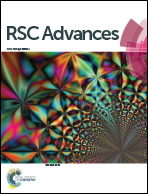Energy and environmental usage of super porous poly(2-acrylamido-2-methyl-1-propan sulfonic acid) cryogel support
Abstract
Superporous and nonporous poly(2-acrylamido-2-methyl-1-propansulfonic acid) [p(AMPS)] cryogels and hydrogels were prepared under freezing conditions (−18 °C) and at room temperature (25 °C), respectively. The swelling equilibrium values of the p(AMPS) cryogels were extremely fast, 3600 fold faster than those of conventional hydrogels. The p(AMPS) cryogels were further employed as highly effective supports for the in situ preparation of metal nanoparticles within superporous networks, by loading Co(II) and Ni(II) ions into the cryogel network from aqueous environments and reducing with NaBH4. The Co metal nanoparticle-containing cryogel composites demonstrated superior catalytic performances in comparison to nonporous p(AMPS) hydrogel composites for energy and environmental applications e.g., hydrogen production from the hydrolysis of sodium borohydride, and reduction of 4-nitrophenol to 4-aminophenol. The energy applications of cryogel-based p(AMPS)–Co metal composites, especially, were investigated in detail. The effect of various parameters on the rate of the hydrogen generation reaction, such as porosity, metal types, pH, the types of reaction water, temperature and reuse of catalyst, were examined for the p(AMPS)–Co cryogel composite materials. With the p(AMPS)–Co cryogel composite a very high hydrogen generation rate of 14 501 mL H2 per min per g of Co was attained. This value is one of the best recorded values in comparison to the values obtained for other similar catalysts reported in the literature. p(AMPS)–Co composite cryogels were repeatedly used without significant loss of catalytic activity (82%) even after five repetitive uses for catalytic hydrolysis reactions with NaBH4. Additionally, a very low activation energy for the p(AMPS)–Co cryogel composite systems was attained: Ea = 15.40 ± 0.3 kJ mol−1.


 Please wait while we load your content...
Please wait while we load your content...